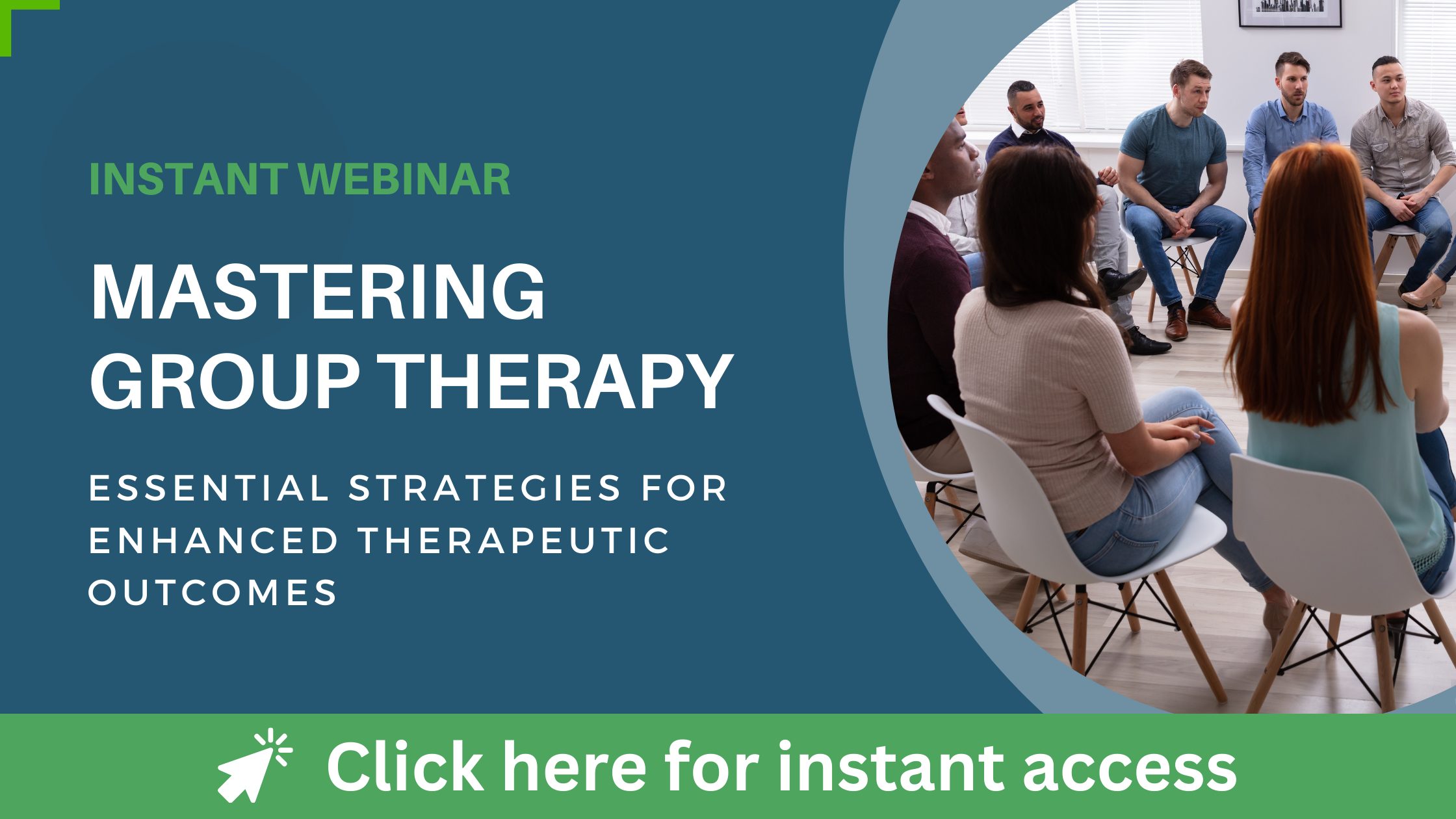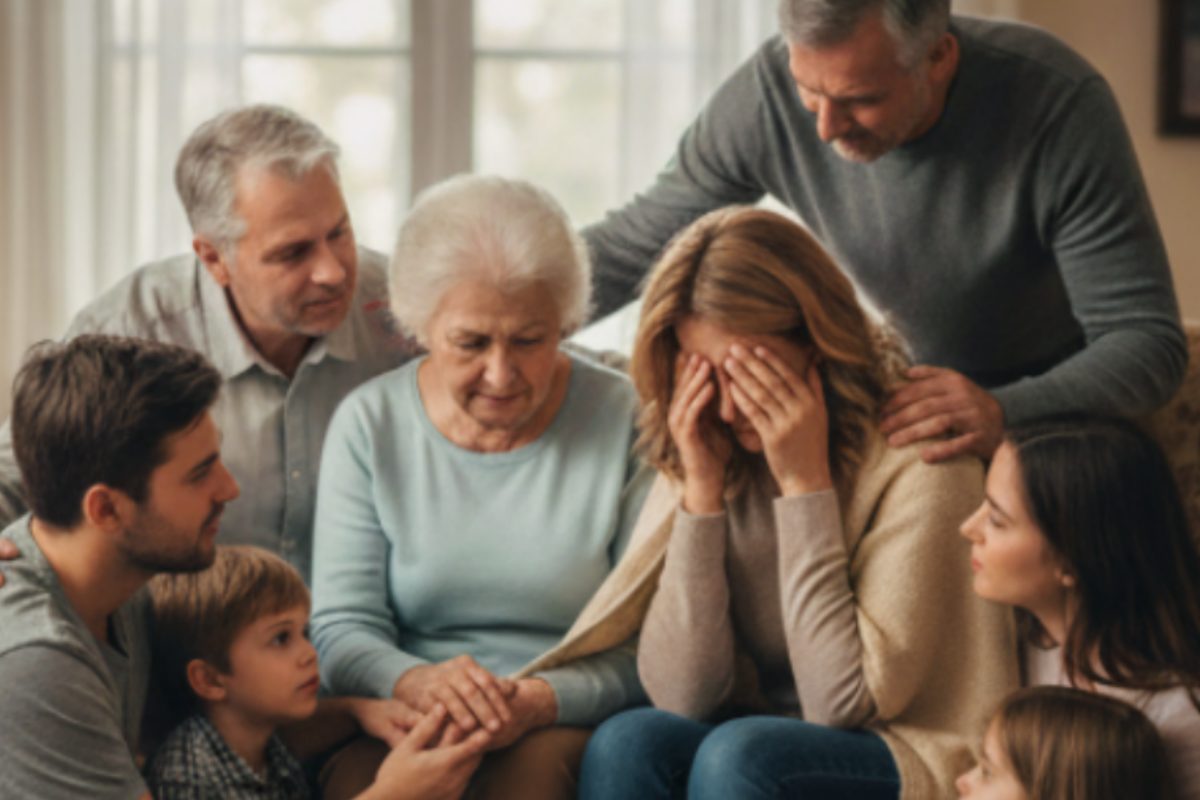Blog > Treatment Strategies > Group Therapy Conflict Resolution: Strategies & Activities
Conflict Resolution in Group Therapy: Strategies and Activities
Conflict is a natural part of human interaction — even in therapeutic settings. In group therapy, unresolved disputes or tensions can derail progress and reduce cohesion. That’s why group therapy conflict resolution is not just helpful but essential. In this post, you’ll learn how to handle conflict in a group setting effectively, discover conflict resolution group therapy activities you can use immediately, and see how using a purpose-built tool like ICANotes can streamline your group therapy workflow.

Last Updated: October 2, 2025

Miscommunication, disagreements, microaggressions, and conflict are common, if not inevitable, aspects of group therapy. Being unable to address or overcome conflict during group therapy can fracture the group and rupture the therapeutic process. But when the therapist is able to identify and resolve conflict quickly and efficiently, conflict in group therapy can become a fantastic growth opportunity for clients.
Why Conflict Arises in Group Therapy
Interpersonal conflicts are a typical and healthy part of interactions, and these conflicts are often apparent in group therapy sessions and mental health treatment. Conflict — if managed well — can catalyze growth, insight, and deeper bonds among group members. But left untreated, it can fragment the group, stifle trust, or drive members away. Some therapists may aim to avoid problems at all costs or act as if conflicts are not present. This could be a mistake, though, as helping clients attend to and act toward conflict resolution and conflict management in the safety of the group setting can help them outside of the session.
Conflicts in group therapy can present in various ways. When the therapist is aware of these types, they can learn how to overcome conflict during group therapy. Common sources of conflict include:
- Disagreements in personality traits, beliefs, and opinions
- Differences in communication styles or cultural norms
- Competing needs for attention or validation
- Perceived favoritism or cliques
- Power struggles, dominance, or resistance
- Opposing treatment goals and unmet expectations about group rules or process
- Frustration over perceptions of honesty and participation in the session
- Conflict that comes from outside the session based on previously held relationships or personal relationships built after the group initiated
Addressing these types of conflict early and explicitly helps maintain safety, structure, and therapeutic momentum.
Group therapy conflicts can occur in several forms including:
- Client vs. client
- Client vs. therapist
- Client subgroup vs. client or another subgroup
- Client subgroup vs. therapist
No form of conflict is better or worse than another, but they all present opportunities for growth, learning, and change.
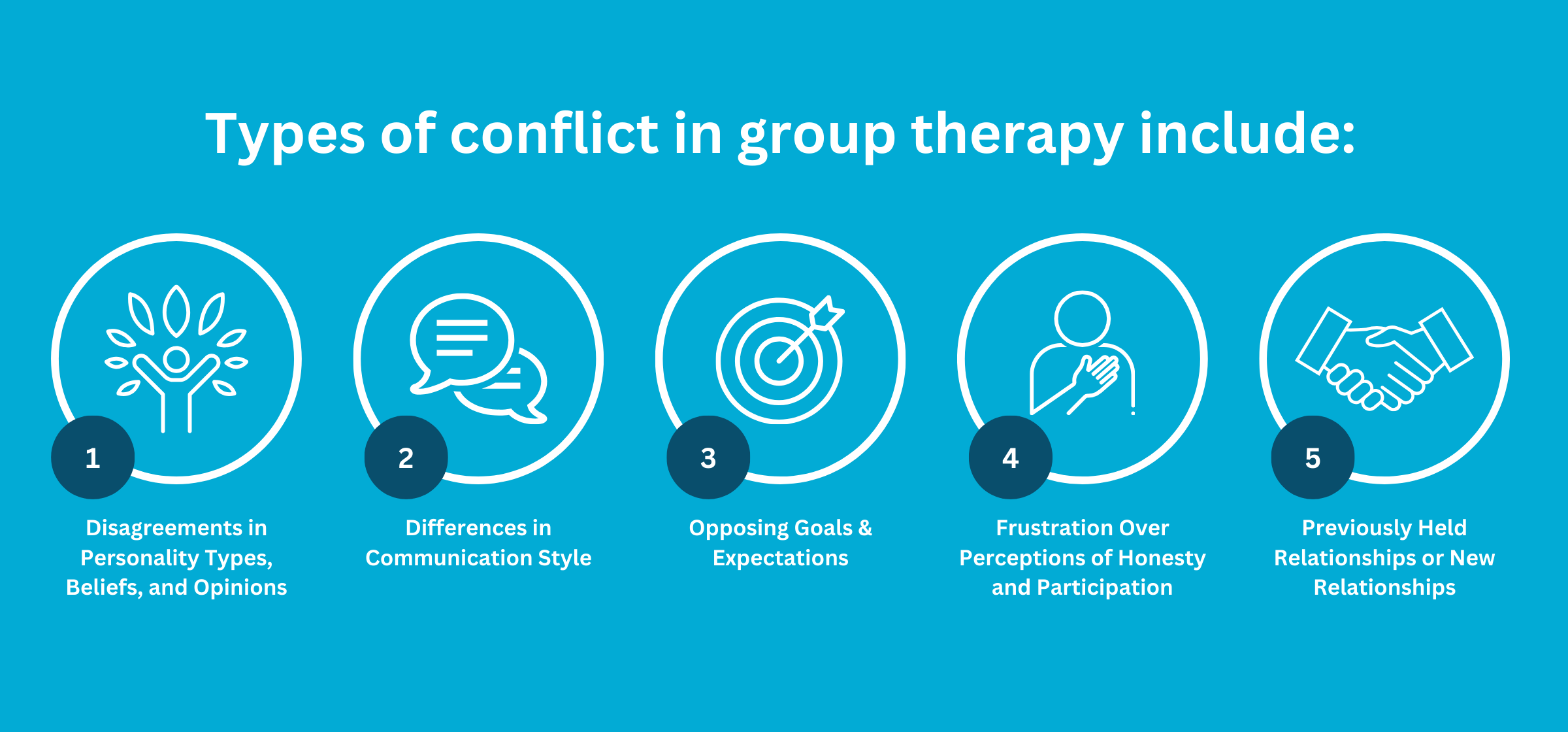
The Role of the Group Therapist
In group therapy conflicts, there is no singular “right” approach or conflict management style for the therapist to take. The strategies and tools therapists use to help deal with therapy conflict will depend on factors like their experience, theoretical orientation, communication style, and stage of the group process.
A great starting point for a group therapist is to provide education and understanding to the group members that conflict is a likely part of the experience. By letting clients know that early group sessions usually are marked by some reluctance and mistrust before the hesitation gives way to openness and intimacy. This phase, sometimes called the storming stage, is where a lot of conflict can begin.
Here, the therapist should take action that is in line with previously established group rules, policies, and procedures. At this point, a therapist may:
- Identify and acknowledge the conflict
- Discuss the impact of conflict on the group process
- Re-establish or maintain group as a safe, open environment
- Speak in ways that emphasizes the differences of opinion, rather than notions of “right and wrong”
- Remain neutral in the conflict, while using empathy to understand the situations of the members
Early on in the group, the therapist may need to take the lead in resolving conflict. This serves to put the group back in a good direction, but it also provides an example to the members about the process of noting, discussing, and resolving group therapy conflicts. As additional conflicts occur, the therapist can take a gradually more passive role and allow the group as an entity to find solutions. In the best of situations, group members can use this information and apply it to their conflicts outside of the group.
Principles of Healthy Conflict Resolution in Groups
For a therapist learning how to handle conflict in group therapy, it’s important to remember that there are countless ways to make the situation better and a few ways to make the situation worse. Controlling, compromising, accommodating, motivational interviewing, and collaborative conflict resolution in group therapy can all be effective when performed in an intentional and skillful way.
Thematically, therapists and mental health professionals should consider some guiding principles of conflict resolution in group sessions like:
-
Normalize conflict: Make it clear that disagreements can emerge and that the group can process them safely.
-
Establish ground rules early: Enforce norms around respectful listening, “I” statements, confidentiality, turn-taking, and nonjudgment.
-
Use process comments: Name what’s happening in the “here and now” (e.g. “I notice a tension in the room”) to bring awareness and de-escalate.
-
Balance inclusion and individuation: Encourage each member to voice their perspective, but also keep group cohesion in mind.
-
Model vulnerability and humility: The therapist can acknowledge their own reactions and missteps when appropriate.
-
Focus on interests, not positions: Help members move from entrenched “positions” to underlying needs or emotions.
-
Set time limits and check-ins: Recognize when tensions are escalating and offer a brief pause or regroup.
- Active listening and empathy: Stay open-minded, nonjudgmental, and fair.
- Mediation and facilitation: Help clients resolve the conflict, don't resolve it for them. Be a mediator, not a fixer.
The specific conflict resolution techniques and conflict resolution group therapy lessons used will depend on the chosen style, but generally, therapists will do well to:
- Set the tone for optimism, success, and resolution
- Illustrate issues and differences creating the conflict
- Work with members to build emotional intelligence and verbalize their feelings, rather than acting out on them
- Focus on the problems, not the other people
- Avoid threats and intimidation
- Promote the importance of relationships in group therapy
- Find ways to meet the needs of the members
- Encourage patience, empathy, and understanding
- Build assertive communication skills, while working to point out passive or aggressive styles
Depending on the phase of the group, the therapist could be very active in leading and mediating the conflict. If the group is well-established, the group as a unit could work towards a resolution, or a group member could emerge as a temporary facilitator to work through the group conflict.

How to Handle Conflict in a Group: Practical Steps
When conflict surfaces, here’s a step-by-step guide for facilitators:
-
Pause and slow down: Don’t rush. Acknowledge the tension and ask for a moment to address it.
-
Check the emotional temperature: Ask each party or the group to rate their current distress or agitation (e.g. 0–10).
-
Ask clarifying questions: Use curiosity to understand: “What’s coming up for you right now?” or “What did you hear?”
-
Reflect back and validate: Summarize each person’s experience without judgment. Validate emotion even if you don’t agree with content.
-
Invite reframing: Help individuals (and group) reframe from blame to “what’s beneath” (e.g. fear, unmet needs).
-
Encourage negotiation or problem-solving: Brainstorm options, evaluate pros/cons, and invite members to propose compromises.
-
Check for agreement and commitment: Ask, “Is this acceptable? Can you try this for our next sessions?”
-
Follow-up: At the next session, circle back and revisit the agreement, checking whether the resolution is holding and adjusting if needed.
Use these steps flexibly, as conflict dynamics differ. Sometimes you’ll need to pull aside one or two members, other times the full group processing is appropriate.
Conflict Resolution Group Therapy Activities
Incorporating structured conflict resolution group therapy activities into your sessions can help members practice communication, build empathy, and transform tension into growth. Below are some practical exercises you can adapt for your groups.
| Activity | Purpose | Instructions / Tips |
|---|---|---|
| “I feel … because …” Round Robin | Encourages expression of underlying emotions and needs | Each person briefly states “I feel <emotion> because I need <need>” related to the conflict; keep it concise and validate each share. |
| Fishbowl with Rotating Roles | Helps members observe and reflect on conflict dynamics | Two members role-play a disagreement while others observe; rotate roles and debrief on what escalated/de-escalated tension. |
| Values vs. Behaviors Sorting | Surfaces gaps between group values and actual behaviors | Provide cards (or a list) of values and behaviors; sort together and discuss discrepancies and commitments for alignment. |
| Conflict Mapping / Timeline | Visualizes how the conflict evolved over time | On a whiteboard or shared doc, map triggers, key moments, escalation points, and potential turning points; identify repair steps. |
| Solution Carousel | Generates multiple options and builds buy-in | Pairs/triads brainstorm solutions, rotate to add improvements, then vote or prioritize; convert top options into concrete agreements. |
| “What I Wish You’d Know” | Builds empathy and perspective-taking | Members write a short note to another person (or the group) about what they wish others understood; share and reflect with ground rules. |
After any activity, debrief to link the exercise back to the group’s relational dynamics, and tie it into the therapeutic goal

Facilitator Guidelines & Tips
-
Watch for triangulation (A speaks to B about C). Bring it back to direct communication.
-
Be alert for subgrouping or alliances that isolate others.
-
Monitor whether someone is silencing another — intervene to uphold fairness.
-
Use check-ins or “temperature checks” at mid-group to catch tensions early.
-
If conflict is too heated, call a “time-out”, use a brief break, and return with a calm, structured intervention.
-
Document the conflict process (e.g. what was resolved, next steps) to revisit and support accountability.
Download our Group Therapy Conflict Resolution Activity List
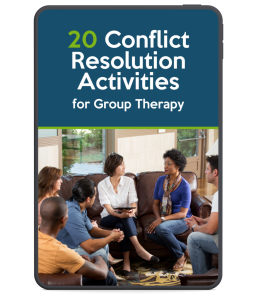
Preventing Future Group Therapy Conflicts
Running a therapy group devoid of conflict may seem ideal, but these challenges experienced during conflict can be invaluable learning opportunities. Because of this, it could be the therapist’s goal to reduce silly, necessary, and repetitive conflicts, rather than reduce all conflict.
Some ways to minimize and prevent future group therapy conflicts include:
- Establishing clear group guidelines and expectations. The rules and expectations of the group process will direct future sessions. Be sure guidelines are clear, helpful, and flexible enough to evolve with time.
- Promoting group cohesion and trust. Maintain the therapy group as a collective team, instead of people competing for time, attention, or praise.
- Focusing on early intervention. The difference between a minor issue and a full-blown conflict often comes down to time. As the therapist, place value on early intervention and have members more quickly identify frustrations before conflict develops.
- Encouraging open and honest communication. Therapists should consider routinely leaving time to discuss and process the group status. Make space to allow and reward communication.
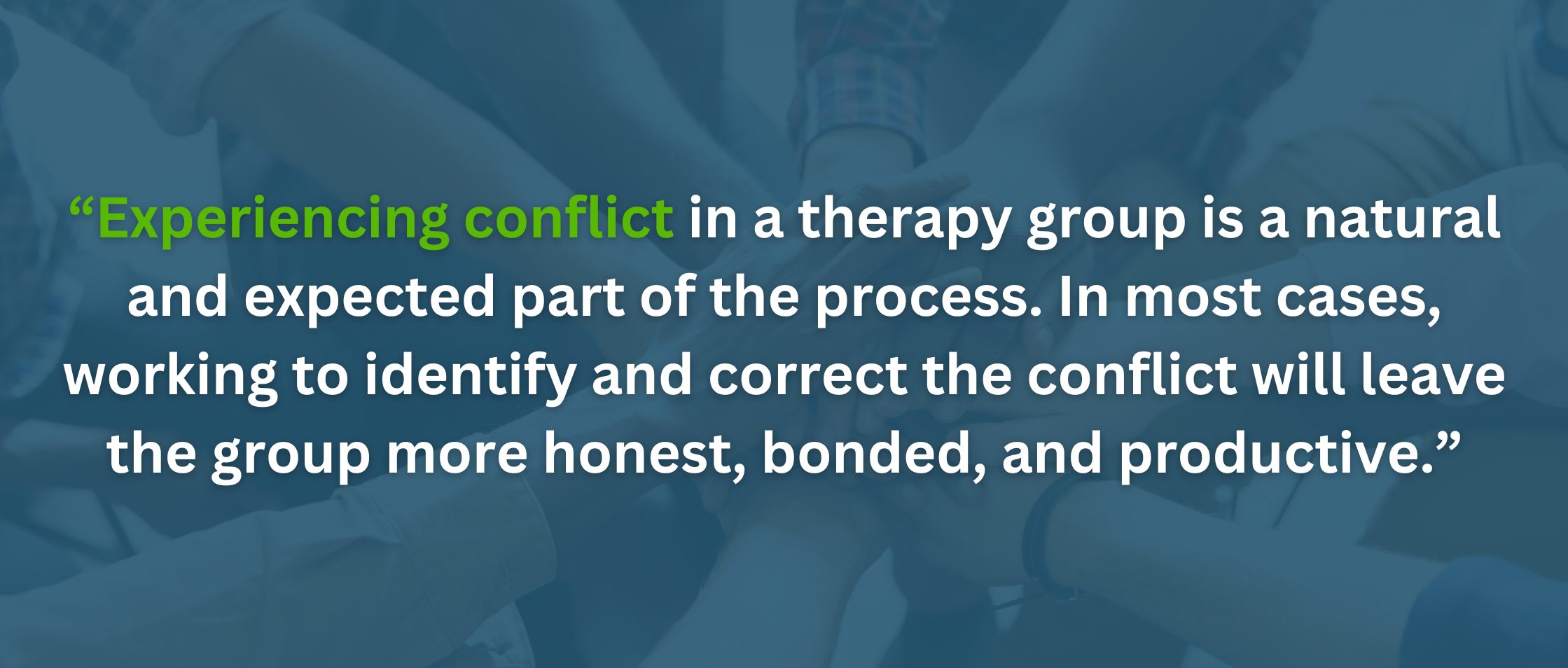
Dealing with Persistent Conflict in Therapy Groups
Even the best therapists and the well-oiled therapy groups could experience persistent conflict due to the interaction of leader and member factors. It takes many people to make a group successful and only one person to upset the balance and trigger a rupture. Dealing with persistent conflict in group therapy may become necessary. Without repairing the rupture, the group could fall apart.
To manage chronic conflict in therapy groups:
- Identify and track recurring conflicts. Is this the first conflict a member has had or is it the 40th? Is it with the same person or are they rotating through each group participant?
- Call attention to these patterns. Noting patterns is not judgmental, so bring this information to the group’s attention. Ask for feedback about possible reasons for these issues.
- Brainstorm solutions. Working with the group as a unit, discuss possible resolutions for the conflicts. Be sure to come from a place of understanding and not blame.
- Refer elsewhere when needed. By no fault of their own, some group members are just not appropriate for every group. By subtracting a member, the remaining members can gain increased cohesion and benefit from therapy.
It’s imperative from an ethical and clinical perspective to avoid abandonment here. If the client is removed from the group, therapists should accurately document their rationale and always refer to follow-up services.
Frequently Asked Questions: Group Therapy Conflict Resolution
Final Thoughts on Group Therapy Conflict Resolution
Conflict in group therapy isn’t a problem to avoid — it’s an opportunity for growth, deeper understanding, and stronger group cohesion. By grounding your approach in principles of respect, transparency, and structured process, and by deploying well-designed conflict resolution group therapy activities, you can transform tension into therapeutic momentum.
If you’re ready to streamline your group therapy documentation and focus more fully on facilitation rather than paperwork, try ICANotes free for 30 days. Experience how a purpose-built group therapy EHR can free your time, maintain compliance, and support your clinical impact.
How ICANotes Supports Group Therapists
One challenge many group therapists face is the administrative burden of managing rosters, documenting shared sessions, and ensuring individualized progress notes. That’s where ICANotes comes in.
Here’s how ICANotes can help you lead therapy groups more smoothly:
-
Group roster & attendance tracking: Set up therapy groups easily, manage member lists, and track attendance.
-
Templated group note content: Use preconfigured content fields (e.g. “Leader Interventions,” “Participation,” “Group Process”) to speed documentation.
-
Push remarks to individual charts: Document your session once, then push relevant session remarks into each participant’s individualized note, saving you time.
-
Automatic carry-forward of key data: Important elements (e.g. risk flags, group norms) can pull forward to reduce redundant documentation.
-
Flexible note styles: Support SOAP, DAP, BIRP, or your preferred note format within structured, compliant workflows.
-
Integrated assessments & progress tracking: Leverage built-in rating scales and link outcomes to group treatment goals.
-
Scheduling & reminders for group sessions: Use calendar tools and automated reminders to reduce no-shows.
-
HIPAA compliance & audit readiness: Ensure your charting meets regulatory standards and is defensible.
With ICANotes, you can spend less time on paperwork and more time guiding your group through meaningful conflict resolution. Start your free trial today (no credit card required) and see how ICANotes can revolutionize your group therapy documentation workflow.
Start Your 30-Day Free Trial
Experience the most intuitive, clinically robust EHR designed for behavioral health professionals, built to streamline documentation, improve compliance, and enhance patient care.
- Complete Notes in Minutes - Purpose-built for behavioral health charting
- Always Audit-Ready – Structured documentation that meets payer requirements
- Keep Your Schedule Full – Automated reminders reduce costly no-shows
- Engage Clients Seamlessly – Secure portal for forms, messages, and payments
- HIPAA-Compliant Telehealth built into your workflow
Complete Notes in Minutes – Purpose-built for behavioral health charting
Always Audit-Ready – Structured documentation that meets payer requirements
Keep Your Schedule Full – Automated reminders reduce costly no-shows
Engage Clients Seamlessly – Secure portal for forms, messages, and payments
HIPAA-Compliant Telehealth built into your workflow
Related Posts
About the Author
Eric Patterson is a professional counselor who has been working for over a decade to help children, adolescents, and adults in western Pennsylvania reach their goals and improve their well-being.
Along the way, Eric worked as a collaborating investigator for the field trials of the DSM-5 and completed an agreement to provide mental health treatment to underserved communities with the National Health Service Corp.

